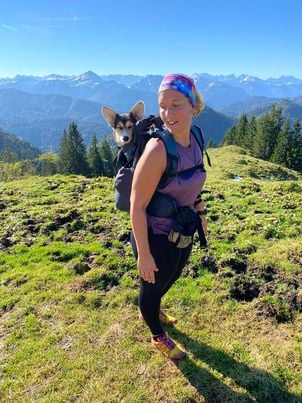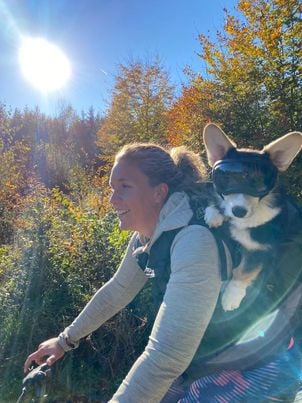On the website of Krytyka Kulinarna Ms. Magda Grzebyk, we found a very interesting article. It is not written by the breeder, and that’s good. It lacks bulging and information unnecessary for anyone. You can see that it is written by a practitioner, i.e. a person who really travels with dogs authentically and not just tells about it. We read this text with great care and found in it a lot of things that we do ourselves traveling with our corgi, both adults and puppies. We encourage you to read:
How to travel with a dog and not go crazy? 10 good tips!
We have been traveling with dogs or dogs for years. Wherever we are able to get by car – they also arrive. First I traveled alone, only with Saba. Later I met Jacek and there were three of us. After another two years, Pola joined, probably the sweetest golden retriever in this part of Europe. The configuration changed when Saba ran out six years later – we were the three of us again. Last fall, a Pretzel joined us. The pretzel is a mini Saba. And again we have a set in the car.

By definition, we do not take animals to the plane, because we have no heart to give them the stress of traveling in the baggage hold. But Europe is theirs. Our dogs swam in the Baltic, the English Channel, the Atlantic Ocean, the North Sea, the Black, Aegean, Mediterranean or Adriatic, rode the cable car in the Italian Alps and made skiers drink bombardino, sailed and had fun to the rhythm of shanties. And they were never a problem but a source of joy for us and the environment.
Maybe we are very lucky, or rather we are always well prepared for travel? Maybe we don’t impose their presence on others and we only enter where we are welcome? We don’t go with them to museums, we just enter them one by one, so that someone can always stay with the dogs outside.
It is worth checking in advance which National Parks you can enter with your dog, and if you can’t, how much is the ticket. For example, in the Bieszczady, you cannot go to the BPN, but the ticket is cheap, so if I meet a guard, I approach him and politely say: “Good morning, please, please.” He writes it out to me and we travel in peace. To this with a smile.
Pubs? Zero problem. It is only in Poland that we twist our nose. Everywhere in the world we were able to find either a restaurant with a garden, or a secluded place inside, where dogs did not bother anyone.
Accommodation? Zero problem. It is only in Poland that we twist our nose. Five-star hotels? You’re welcome! Apartments? You’re welcome! Probably a big merit in this buttered Polish eyes, which cannot be denied, but equally large ours. All the work we did with our dogs to make them criminal, obedient and not pull the dermis out of their seats. It’s just like with kids in restaurants – well-behaved they do not hurt anyone, but completely dissolved you want to pour on your bare ass. And just as I do not like dissolved children, I do not support traveling with an aggressive or untrained dog.

Here are ten points to uncheck so you can remember your vacation with your dog well. And the dog maybe even better.
1. Raise your dog
In fact, preparations begin at the puppy age. If you devote a lot of attention to your dog during the first year, work with him, then for the next 12 years you will not have to be ashamed of him. Instead of teaching him stupid tricks, teach him how to reference, stop, stop or down.
“To my feet” will come in handy when your cute pet wants to say hello to this baby here and his mummy gets into hysteria because her cousin once bit a dachshund. It is better not to provoke and just call the dog. “Lay down” and “stay” will be useful in a restaurant so that your sweetie lies under the table and does not put – even the sweetest – muzzle other guests in plates. When all this is able and politely walks by the leg, then there is time for stupid fools like “roll, everyone will have a back”.
And take him not only to the forest, but also to the city. Let him get used to a massive stimulus attack. Thanks to this, the new surroundings will not surprise him and he will accept any changes in landscape with stoic calmness.
2. Vaccinations
It’s your dog’s duty to watch over them. Remember that rabies vaccination only takes effect after three weeks, so you must vaccinate your dog well in advance of your planned departure date.
3. Chip and passport
A one-off action costs just over PLN 100. Once a passport is issued, it is always assigned to the dog. As a rule, at the borders no one asks about him, but you always have to have with you.
The chip is theoretically a great thing to identify a dog if he decides to go on an independent trip. BUT. First of all, someone who finds out that the dog can be chipped must find it. Secondly, he must find a vet who has a reader, which is not so obvious. And thirdly – the data must be entered into the international Safe Animal database. The vet has no such obligation, so do it yourself. In addition, when you create an account, you will be able to change data, e.g. when you change your phone number or home address.
4. Address card
Analog version of the chip. Always, always the dog should have it attached to the collar. I do not recommend screwed sleeves with paper inside. It is much more reasonable to order an address in the form of a piece of metal with embossed data. Remember to provide the telephone number with the area code to Poland, i.e. in the format +48 xxx xxx xxx.
5. Protection against ticks and fleas
Our dogs in warm places never caught anything. They bring the most ticks from our own garden and I have such observations that they are no longer called anything. These ticks. But it’s worth trying. And remember that if you use a spot-on agent, for the next three days after instillation, the dog should not enter the water. In turn, the collar should be removed before bathing. Even those described as “waterproof” are not quite that at all. The rain won’t hurt them, but the salt water will.
6. Braces for the car or transporter
Depending on how your dog is used to it. Our dogs travel in the back seat, but if your dog feels safer in the transporter, then remember to leave enough space for him in the trunk, and put his home den inside. It will feel even safer with familiar fragrances.
7. Bowl and water
It’s something you can’t forget. Silicone folding bowls are a nice solution. They take up very little space, so they are easy to throw even into a backpack. Remember to supply fresh water.
8. Break every 3-4 hours
Roughly so often we stop to dry dogs, give them water and let their legs stretch out. They don’t complain and the rest of the way sleeps well. Sometimes I feel a little jealous of them.
9. Own food
I know from experience that it will be better if you take the right supply. If your dog eats specialized food, it is not at all discussed. Ours eat completely normal food, but rather from the shelf of ham, not pate. Once, we took too little to Greece, so I bought a small pack of some well-known P letter food in the supermarket. The second part of the name was also P. After three days, the Polish woman began to bald around the stomach. It ended up in a bare pie that overgrown for another month. It had to be delicious food and extremely healthy. Take your own. Always.
10. Leash and muzzle
Even if you have the best-placed dog in the world and communicate with a complex system of looks and grunts – there will always be a situation where a leash will be indispensable. Either they won’t let you into the restaurant without her or that mommy dachshund. In general, always have a leash. Muzzle too. Of course, if you have a totally peaceful dog, it’s likely that the muzzle will never be useful. But let’s assume that this dachshund mommy is going to make a rabbi. And then what? You won’t tie his mouth with a string.
So prepared, you have nothing to fear. Traveling with a dog is fun, good and glorious, so do not regret it!